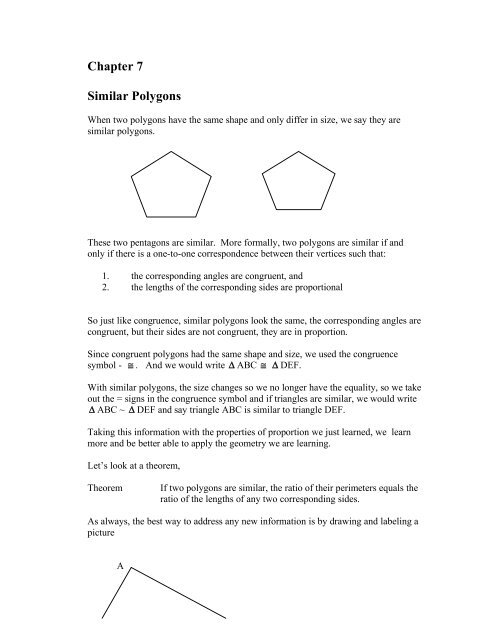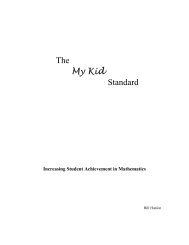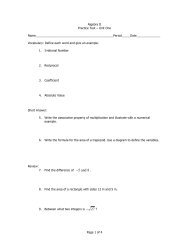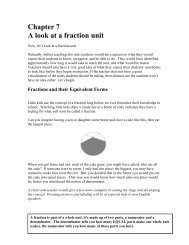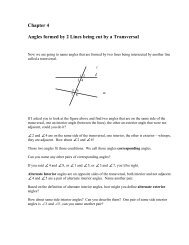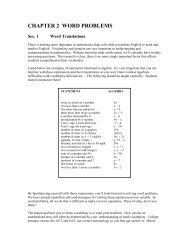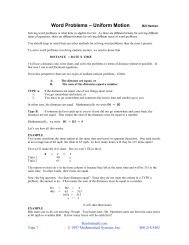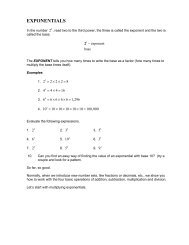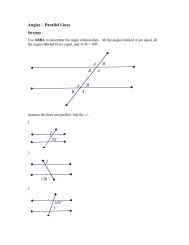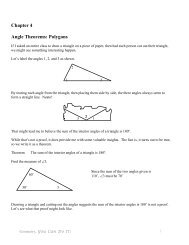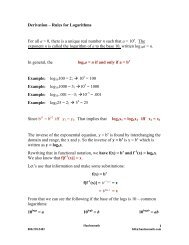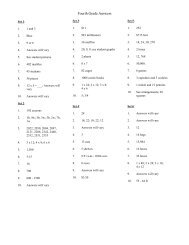Chapter 7. Similar Polygons - Hanlon Math
Chapter 7. Similar Polygons - Hanlon Math
Chapter 7. Similar Polygons - Hanlon Math
You also want an ePaper? Increase the reach of your titles
YUMPU automatically turns print PDFs into web optimized ePapers that Google loves.
<strong>Chapter</strong> 7<strong>Similar</strong> <strong>Polygons</strong>When two polygons have the same shape and only differ in size, we say they aresimilar polygons.These two pentagons are similar. More formally, two polygons are similar if andonly if there is a one-to-one correspondence between their vertices such that:1. the corresponding angles are congruent, and2. the lengths of the corresponding sides are proportionalSo just like congruence, similar polygons look the same, the corresponding angles arecongruent, but their sides are not congruent, they are in proportion.Since congruent polygons had the same shape and size, we used the congruencesymbol - ! . And we would write ! ABC ! ! DEF.With similar polygons, the size changes so we no longer have the equality, so we takeout the = signs in the congruence symbol and if triangles are similar, we would write! ABC ~ ! DEF and say triangle ABC is similar to triangle DEF.Taking this information with the properties of proportion we just learned, we learnmore and be better able to apply the geometry we are learning.Let’s look at a theorem,TheoremIf two polygons are similar, the ratio of their perimeters equals theratio of the lengths of any two corresponding sides.As always, the best way to address any new information is by drawing and labeling apictureA
DB C E FPerimeter of ∆ABCPerimeter of ∆DEF=ABDETo prove this theorem, all we have to do is use the last property of proportion westudied.We know if the polygons are similar, the sides are in proportion. That isAB BC ACDE = EF = DFThe last property of proportion allows me to take the sum of the numerators and placethat result over the sum of the denominators. Those sums are the perimeters of thetwo triangles.Angle – Angle PostulateUp to this point, the only way we could show triangles similar was by the definition.The next postulate is really going to make our lives easier with respect to triangles.PostulateIf two angles of one triangle are congruent to two angles of anothertriangle, the triangles are similar.The reason this is a postulate is that we cannot prove it, but as we examine more andmore cases, this seems to hold up. Since it does, we accept it as true without proof.Any postulate or theorem that has a name must be important, so make sure you knowwhat this one says and means. Like ll theorems and postulates, this is a shortcut.Rather than showing all angles are congruent and the corresponding sides are inproportion, all I have to is show two angles congruent.Using this postulate, let’s see what doors that can open to make more observations.
TheoremIf an angle of one triangle is congruent to an angle of anothertriangle and the lengths of the sides including those angles areproportional, the triangles are similar.TCABRSGiven: ∆ABC and ∆RST with ! C ! ! T and AC BCRT=STProve:∆ABC ~ ∆RSTTo prove that theorem, I will have to use a couple of strategies. The first is to drawand label the picture. The second is to bring in other information. I know the 2angles are equal, that’s a start. Now what I can do is pick a point X on TR so thatTX = CA, then draw XY || RS.Let’s see what that looks like and how that allows me to play with the geometry Ialready know.TXYRS∆TXY ~ ∆TRS by the Angle-Angle Postulate, that results inTXRTTY= Cross multiplying results in TX ST = RT TY. By substituting ACSTfor TX, we have AC ST = RT TYBy the proportion given to us in the problem, we have AC ST = RT BC by crossmultiplying. Again, by substitution, we have RT TY = RT BC or BC = TY bydividing out the RT on each side. The rest follows easily.
Let’s try another one.AXDGiven: AC || BDProve: ∆AXC ~ ∆BXDCBStatementsReasons1. AC || BD Given2. ! A ! ! B 2 || lines cut by a transversal,alt int. angles are congruent3. ! AXC ! ! BXD Vertical angles are congruent4. ∆AXC ~ ∆BXD Angle- angle PostulateOnce we know triangles are similar, we then know by definition the sides are inproportion. This will allow us to find lengths of sides of triangles.
Applications: <strong>Similar</strong> ! ’sWe learned the sides of similar polygons are in proportion. Using that information, we are ableto solve problems.If we continued in our study, we might be able to draw some more conclusions based on ourobservations.TheoremIf a line is parallel to one side of a triangle and intersects the other twosides, it divides them proportionally.ACX 3 X 4 Y1 2BGiven: ! ABC, XY || ABProve:AXXC = BYYCStatementsReasons1. XY II AB Given2. ! 1 ! ! 3, ! 2 ! ! 4 || lines cut by t. corr. angles3. ! ABC ~ ! XYC AA Postulate4.ACXC = BCYC<strong>Similar</strong> ! ’s5. AX + XC = AC Segment Addition ThmBY + YC = BC5.AC - XCXC=BC - YCYCProp of pro.6. AC – XC = AX Sub. prop =.BC – YC = BC<strong>7.</strong>AXXC = BYYCSubstitution
Following as a direct result of that theorem, we have the following corollary.CorollaryIf three parallel lines intersect two transversals, they divide themproportionally.Moving along, we have another theorem.TheoremIf a ray bisects an angle of a triangle, it divides the opposite side intosegments whose lengths are proportional to the lengths of the other twosides.Given:Prove:∆ LMNLP bisects ! MLNMPPN = LMLNY 2 4L13MPNStatementsReasons1. ∆ LMN GivenLP bisects ! MLN2. Extend ML, YN || LP Construction3.MPPN = LMLYfor ∆MYN4. ! 1 = ! 2 Corr ! ’sline ||, divides ∆ pro5. ! 1 = ! 3 Def ! bisector6. ! 3 = ! 4 Alt int ! ’s<strong>7.</strong> ! 2 = ! 4 Sub8. LY = LN Base ! ’s ! , opp. sides !9.MPPN = LMLNSub in step 3In this proof, we drew the picture, then we added on to that picture so we could use ourpreviously learned knowledge of geometry.
Isn’t this stuff neat? These theorems and postulates will allow us to find lengths of linesegments using similar triangles.Let’s find the height of a building using similar triangles.A 6 foot tall person casts a shadow 2 feet long. A building’s shadow is 30 feet long, how tall isthe building?Drawing s picture, we have Mr. Man, Mr. Sun, and Mr. Building.Because of the sun’s distance from the earth, the top angles will be the same. We also haveright angles, therefore by the AA Postulate, the triangles are similar.height of manlength of shadow =height of bldg.length of shadow6 ft.2 ft. 30 ft.hJust looking at thetriangles without theman and building andfilling in the numbers6 h2 30 =2h = 180h = 90The height of the building is 90 feet.


